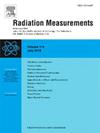Development of a Ce:GPS scintillator-based spectrometer and its demonstration in radioactive cesium contamination sites
IF 2.2
3区 物理与天体物理
Q2 NUCLEAR SCIENCE & TECHNOLOGY
引用次数: 0
Abstract
Following the Fukushima Daiichi Nuclear Power Plant accident, radioactive cesium contamination posed a significant environmental concern. This study developed a compact gamma-ray spectrometer utilizing a Gd2Si2O7:Ce (Ce:GPS) scintillator and a compact photomultiplier tube (PMT) for environmental monitoring. The spectrometer was designed to overcome the limitations of traditional NaI(Tl) detectors, leveraging the non-hygroscopic nature and high energy resolution of Ce:GPS scintillators. Performance was evaluated through measurements of a137Cs source and a comparison with a commercial NaI(Tl) survey meter. The spectrometer's potential for effective and portable monitoring of radioactive cesium in contaminated environments was demonstrated. The system was tested using sealed sources, confirming its ability to detect the 662 keV photopeak of 137Cs with high accuracy. The energy resolution of this photopeak was 10.8 % FWHM. Field measurements in radiocesium-contaminated areas showed the spectrometer's effectiveness in detecting dose rate variations and high-dose hotspots. This portable, durable spectrometer shows promise for applications in environmental radiation monitoring and remote sensing technologies.
基于Ce:GPS闪烁体的光谱仪的研制及其在放射性铯污染现场的演示
福岛第一核电站事故后,放射性铯污染引发了严重的环境问题。本研究利用Gd2Si2O7:Ce (Ce:GPS)闪烁体和紧凑型光电倍增管(PMT)开发了一种紧凑型伽马射线光谱仪,用于环境监测。该光谱仪旨在克服传统NaI(Tl)探测器的局限性,利用Ce:GPS闪烁体的非吸湿性和高能量分辨率。通过对a137Cs源的测量以及与商用NaI(Tl)测量仪的比较来评估其性能。证明了该光谱仪在污染环境中有效、便携监测放射性铯的潜力。该系统使用密封光源进行了测试,证实其能够以高精度检测137Cs的662 keV光峰。该峰的能量分辨率为10.8% FWHM。在放射性污染地区的现场测量表明,该光谱仪在检测剂量率变化和高剂量热点方面是有效的。这种便携式、耐用的光谱仪在环境辐射监测和遥感技术中显示出应用前景。
本文章由计算机程序翻译,如有差异,请以英文原文为准。
求助全文
约1分钟内获得全文
求助全文
来源期刊

Radiation Measurements
工程技术-核科学技术
CiteScore
4.10
自引率
20.00%
发文量
116
审稿时长
48 days
期刊介绍:
The journal seeks to publish papers that present advances in the following areas: spontaneous and stimulated luminescence (including scintillating materials, thermoluminescence, and optically stimulated luminescence); electron spin resonance of natural and synthetic materials; the physics, design and performance of radiation measurements (including computational modelling such as electronic transport simulations); the novel basic aspects of radiation measurement in medical physics. Studies of energy-transfer phenomena, track physics and microdosimetry are also of interest to the journal.
Applications relevant to the journal, particularly where they present novel detection techniques, novel analytical approaches or novel materials, include: personal dosimetry (including dosimetric quantities, active/electronic and passive monitoring techniques for photon, neutron and charged-particle exposures); environmental dosimetry (including methodological advances and predictive models related to radon, but generally excluding local survey results of radon where the main aim is to establish the radiation risk to populations); cosmic and high-energy radiation measurements (including dosimetry, space radiation effects, and single event upsets); dosimetry-based archaeological and Quaternary dating; dosimetry-based approaches to thermochronometry; accident and retrospective dosimetry (including activation detectors), and dosimetry and measurements related to medical applications.
 求助内容:
求助内容: 应助结果提醒方式:
应助结果提醒方式:


